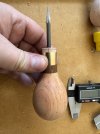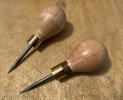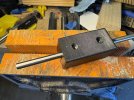I'm making some birdcage awls. I currently have blades (or shafts or whatever they are called in an awl, the pointy steel part) that will be 2" long outside the handle once everything is done, but they're not epoxied into the handle yet. I came up with this by just prototyping a bunch and seeing what felt good. The handle I have made is about 2-7/8" and is a shape that lets me hold onto either just the handle, or choke up and hold the handle higher up in my hand and have my index finger and thumb on the blade, which felt like it would let you really put the point where you want it easily with one hand.
I'm having some second thoughts on the length now. It's much easier to make longer blades now since nothing is epoxied in. Paul Sellers' video and article on the subject shows blades about the length of mine, or shorter. But now I am noticing a lot of commercially available birdcage awls like the Narex, Czeck Edge and Shenandoah Toolworks blades are around 3.5" long.
Does anyone have any thoughts about what an ideal length is?
(Attached picture is one of the awls. The the front end of the handle still needs trimming to be flush with the ferrule.)
I'm having some second thoughts on the length now. It's much easier to make longer blades now since nothing is epoxied in. Paul Sellers' video and article on the subject shows blades about the length of mine, or shorter. But now I am noticing a lot of commercially available birdcage awls like the Narex, Czeck Edge and Shenandoah Toolworks blades are around 3.5" long.
Does anyone have any thoughts about what an ideal length is?
(Attached picture is one of the awls. The the front end of the handle still needs trimming to be flush with the ferrule.)



